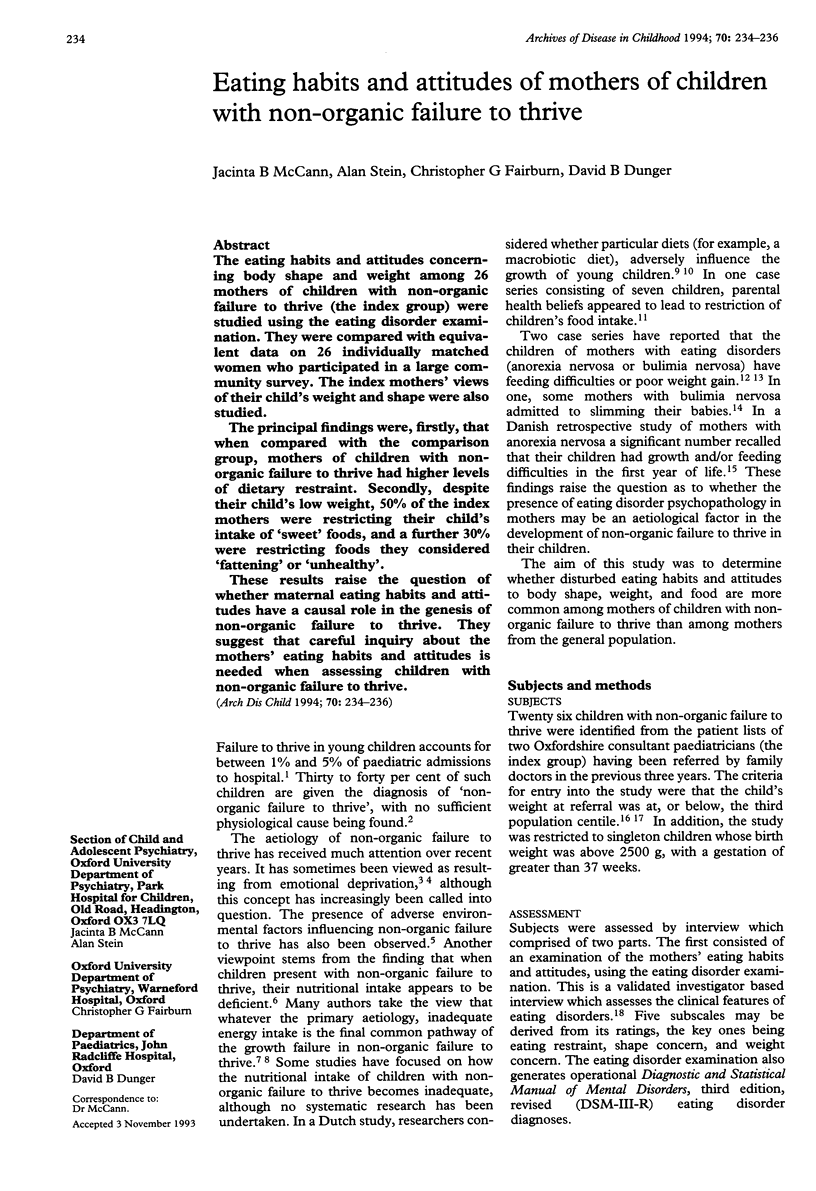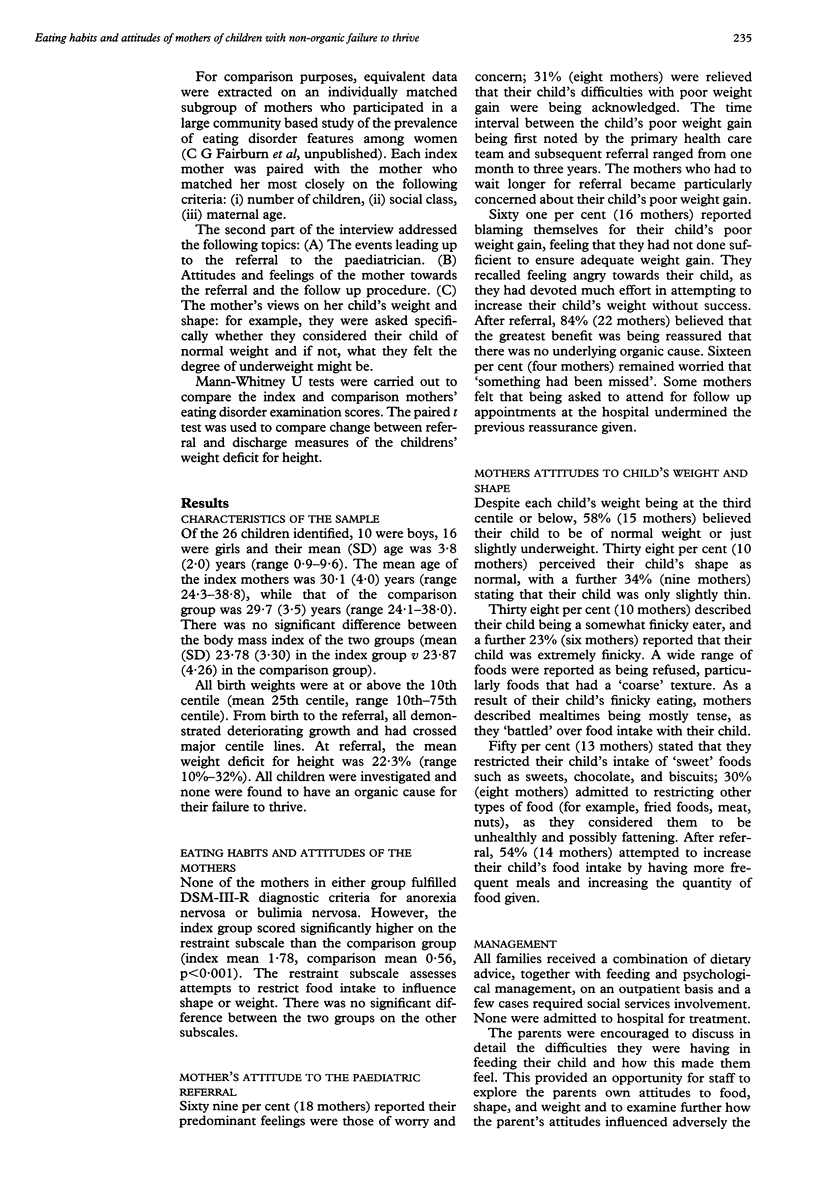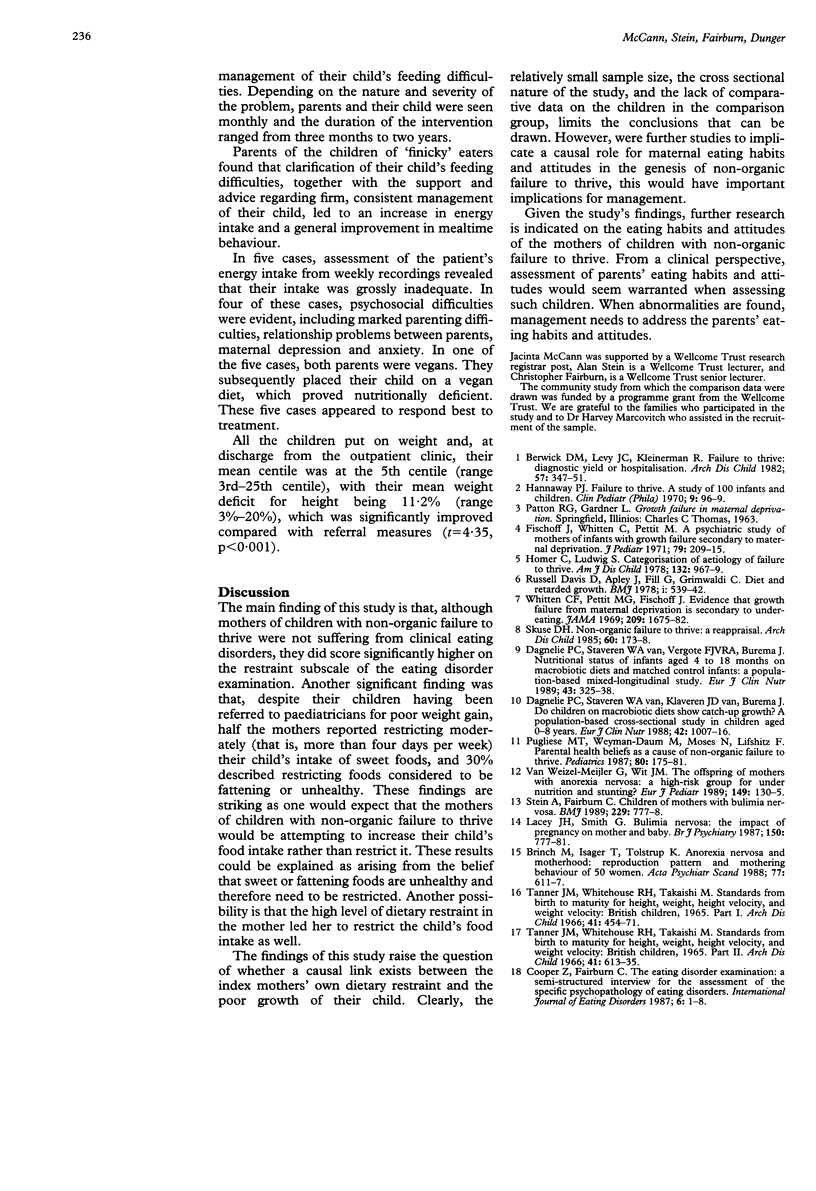Abstract
The eating habits and attitudes concerning body shape and weight among 26 mothers of children with non-organic failure to thrive (the index group) were studied using the eating disorder examination. They were compared with equivalent data on 26 individually matched women who participated in a large community survey. The index mothers' views of their child's weight and shape were also studied. The principal findings were, firstly, that when compared with the comparison group, mothers of children with non-organic failure to thrive had higher levels of dietary restraint. Secondly, despite their child's low weight, 50% of the index mothers were restricting their child's intake of 'sweet' foods, and a further 30% were restricting foods they considered 'fattening' or 'unhealthy'. These results raise the question of whether maternal eating habits and attitudes have a causal role in the genesis of non-organic failure to thrive. They suggest that careful inquiry about the mothers' eating habits and attitudes is needed when assessing children with non-organic failure to thrive.
Full text
PDF


Selected References
These references are in PubMed. This may not be the complete list of references from this article.
- Berwick D. M., Levy J. C., Kleinerman R. Failure to thrive: diagnostic yield of hospitalisation. Arch Dis Child. 1982 May;57(5):347–351. doi: 10.1136/adc.57.5.347. [DOI] [PMC free article] [PubMed] [Google Scholar]
- Brinch M., Isager T., Tolstrup K. Anorexia nervosa and motherhood: reproduction pattern and mothering behavior of 50 women. Acta Psychiatr Scand. 1988 May;77(5):611–617. doi: 10.1111/j.1600-0447.1988.tb05175.x. [DOI] [PubMed] [Google Scholar]
- Dagnelie P. C., van Staveren W. A., Vergote F. J., Burema J., van't Hof M. A., van Klaveren J. D., Hautvast J. G. Nutritional status of infants aged 4 to 18 months on macrobiotic diets and matched omnivorous control infants: a population-based mixed-longitudinal study. II. Growth and psychomotor development. Eur J Clin Nutr. 1989 May;43(5):325–338. [PubMed] [Google Scholar]
- Dagnelie P. C., van Staveren W. A., van Klaveren J. D., Burema J. Do children on macrobiotic diets show catch-up growth? A population-based cross-sectional study in children aged 0-8 years. Eur J Clin Nutr. 1988 Dec;42(12):1007–1016. [PubMed] [Google Scholar]
- Davis D. R., Apley J., Fill G., Grimaldi C. Diet and retarded growth. Br Med J. 1978 Mar 4;1(6112):539–542. doi: 10.1136/bmj.1.6112.539. [DOI] [PMC free article] [PubMed] [Google Scholar]
- Frances Dominica Mother A message from Mother Frances Dominica, founder of Helen House Hospice for Children. J Adv Nurs. 1987 Mar;12(2):149–150. doi: 10.1111/j.1365-2648.1987.tb01314.x. [DOI] [PubMed] [Google Scholar]
- Hannaway P. J. Failure to thrive: a study of 100 infants and children. Clin Pediatr (Phila) 1970 Feb;9(2):96–99. doi: 10.1177/000992287000900214. [DOI] [PubMed] [Google Scholar]
- Lacey J. H., Smith G. Bulimia nervosa. The impact of pregnancy on mother and baby. Br J Psychiatry. 1987 Jun;150:777–781. doi: 10.1192/bjp.150.6.777. [DOI] [PubMed] [Google Scholar]
- Pugliese M. T., Weyman-Daum M., Moses N., Lifshitz F. Parental health beliefs as a cause of nonorganic failure to thrive. Pediatrics. 1987 Aug;80(2):175–182. [PubMed] [Google Scholar]
- Skuse D. H. Non-organic failure to thrive: a reappraisal. Arch Dis Child. 1985 Feb;60(2):173–178. doi: 10.1136/adc.60.2.173. [DOI] [PMC free article] [PubMed] [Google Scholar]
- Stein A., Fairburn C. G. Children of mothers with bulimia nervosa. BMJ. 1989 Sep 23;299(6702):777–778. doi: 10.1136/bmj.299.6702.777. [DOI] [PMC free article] [PubMed] [Google Scholar]
- Tanner J. M., Whitehouse R. H., Takaishi M. Standards from birth to maturity for height, weight, height velocity, and weight velocity: British children, 1965. I. Arch Dis Child. 1966 Oct;41(219):454–471. doi: 10.1136/adc.41.219.454. [DOI] [PMC free article] [PubMed] [Google Scholar]
- Tanner J. M., Whitehouse R. H., Takaishi M. Standards from birth to maturity for height, weight, height velocity, and weight velocity: British children, 1965. II. Arch Dis Child. 1966 Dec;41(220):613–635. doi: 10.1136/adc.41.220.613. [DOI] [PMC free article] [PubMed] [Google Scholar]
- Whitten C. F., Pettit M. G., Fischhoff J. Evidence that growth failure from maternal deprivation is secondary to undereating. JAMA. 1969 Sep 15;209(11):1675–1682. [PubMed] [Google Scholar]
- van Wezel-Meijler G., Wit J. M. The offspring of mothers with anorexia nervosa: a high-risk group for undernutrition and stunting? Eur J Pediatr. 1989 Nov;149(2):130–135. doi: 10.1007/BF01995864. [DOI] [PubMed] [Google Scholar]


